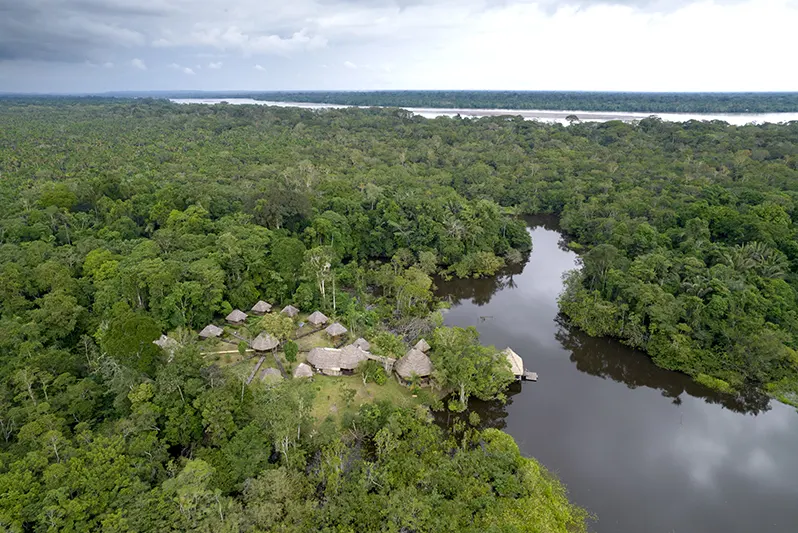Ecuador inspires!
We arrived in the country of the 4 worlds, the Avenue of the Volcanoes according to Humboldt and the inspiration for Darwin in his theory of the origin of the species, while Mark, my travel companion, affirmed that Ecuador is the summary of all South America besides Galapagos.
Heading to the Amazon
Sani Lodge has a long history in the world of birds; it was the first community enterprise in the Ecuadorian Amazon dedicated to sustainable tourism, for which it is recognized as a leader in the region.
The people of Sani have learned English as a communication tool because the art of birdwatching is in their genes due to their intrinsic relationship with their home, the forest, which allows them to become birdwatchers from a very young age, distinguishing colors, shapes, and sizes of the local avifauna without the need of Swarovski or Leika.
We start the adventure from Coca, Yutzu, our guide, whose Kichwa name translates as «strong,» and gives us instructions for safe navigation in the waters of the Napo River, the main tributary of the Amazon. He also mentions that in Sani, there are about 565 species of birds, a third of all the species that exist in Ecuador, 30 % of which we could observe in our 3-night stay. What a number!

We arrived at the entrance to the lodge to change to a paddle canoe to navigate quietly in the black water creek of the Challwayacu River, which is one meter deep and about 15 meters wide with high vegetation. Spectacular. We had the impression of being in a mature forest on the mainland, but it was a seasonally flooded forest.
As soon as we started the silent navigation, the song of a white-throated toucan could be heard in the distance. Suddenly, Yutzu pointed with his finger, and we could not believe it. It is one of our target birds, the Cocha Antshrike male; what a way to start our trip. The 30 minutes to the lodge, we observed large groups of hundreds of breeding Greater Ani, White-chinned jacamar, two species of oropendolas, and finally, the endemic Hoatzin, whose individuals were so numerous that seemed they made us a court of honor to the lodge.
Night canoe ride and walk
At sunset, we went to the lagoon and walked into the forest to enjoy what Mother Earth had for us. Flycatchers, cardinals, Crested & Spectacled Owl, and Black-crowned night herons were on the menu this day before returning to the Lodge, where Trole, the bartender, had two surprises for us: the first an ice-cold juice that refreshed us from head to toe while spotting a Tawny – bellied screech Owl that had perched in one of the ceiling beams in search of bats, what a beautiful surprise, pagrachu.
Dinner time is the moment for Yutzu to explain the next day’s activity, which included a visit to the observation tower at 5:00 a.m. followed by a full day hike in the forest to enjoy the Amazonian sunrise and the awakening of the birds.
Day 2
Yutzu, with his assistant Elias, paddled across the Challwacocha lagoon while showing us a flock of Mealy Amazon heading to the salt lick as well as macaws of all sizes, flycatchers, anis, cardinals that were very active in search of their first food.
We crossed a forest of Montricardia, a Phylodendrum species whose structural beauty is hard to describe. We couldn´t imagine being so deep in the Amazon forest and very happy for the 4 species of Kingfishers, a sungrebe, capped heron that we watched on the way that leads to the tower.
The Canopy Tower
The welcoming was a group of Many-banded aracarí and a mixed group of tanagers- honeycreepers- euphonious barbets in a mosaic of bright colors ranging from yellow, red, turquoise, orange, indigo blue to lime Green. It was hard to focus on just one as there were so many moving around while Yutzu was working hard to tell us their names. The checklist included Turquoise, Flame-crested, Opal-rumped, and opal-crowned tanagers, Golden and orange-bellied euphonious, Green and purple honeycreepers, Lemon-throated barbet,
The activity was getting lower as the temperature got higher. However, Elías got great views of Spangled & Plum throated Cotinga through the spotting scope while Yutzu asked to be quiet because a considerable bird was perching nearby. We passed the device, and he focused on it, harpía said, looking very excited, which drove us crazy as a Harpy Eagle sat in the treetops. What else could we ask for?
Once the activity was over in the treetops, we headed down to spend the rest of the day on the understory searching for antbirds and manakins. Among the outstanding birds, we count the Lunulated antbird, Fulvous antshrike, Long-tailed potoo, and Wire-tailed manakin. We returned to the lodge around 4:00 p.m. for a refreshing bath and a well-deserved beer.


Another birding spot: The bar
While enjoying the beer, a Silver-beaked tanager flew by; thus, we got the binoculars handy again to see what else the afternoon had to offer. Long-billed woodcreeper, a pair of Masked -crimson tanager, the infallible Hoatzin, besides Yellow-rumped cacique mixed with Russet-backed oropendola, were building their nests with palm fibers from the surroundings.
Late at night, before bed, we made the checklist with 135 bird species.
Day 3
The Clay licks
We head back to the Napo River at 6:00 a.m. to visit the clay licks and the islands for another full day. We took the motor canoe for a 30-minute boat ride to the Parrot One in the Yasuní National Park. For these birds, it is vital to transmit information from parents to children on how to get there besides getting ready and activating the survival instinct when a raptor or a boa could be camouflaged in the trees.
Fabulous show, hundreds of dusky-headed and White-eyed parakeets, Blue-headed, yellow Crown & Mealy Amazon Parrots were eating the clay that allows them to absorb minerals while detoxifying from the unripe fruits they ingest in their daily diet.
The following salt lick is a hide where hundreds of Cobalt-winged parakeets ingested dissolved minerals in the water accumulated on the ground with the companion of Scarlet Macaw and Orange cheek parrot in another colorful gift from nature.
The Islands
The islands offered good chances to watch Orange-backed troupial as well as Olive spotted hummingbirds, Fuscous flycatchers, Black and White antbirds, WhiteO bellied & dark-breasted spinetails, and Orange-headed tanagers, to name the most outstanding. It is 4 p.m. to go home for dinner, make the checklist, and final count, which yielded 185 species.
Everything comes to an end
The lodge manager thanked us for visiting the community enterprise that protects 40,000 hectares of rainforest for the world and briefed us regarding the departure procedure to the so-called civilization. Mark mentioned that we should have booked at least one more night because we missed the house specialty, Rufous Potoo, Black-necked-red Cotinga, besides some mixed flocks in the understory and middle strata.
Yutzu dropped us off at the Coca airport and asked our final question about whether this trip was always excellent, to which he replied, «The forest is always generous; it all depends on the attitude of the guests; thanks for being good travel mates.»



Comments